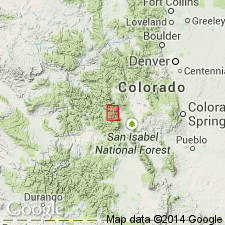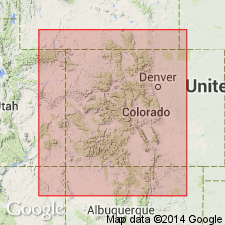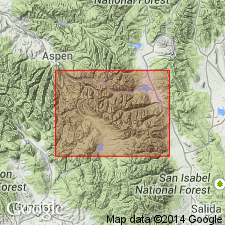
- Usage in publication:
-
- Browns Pass Quartz Monzonite*
- Modifications:
-
- Named
- Dominant lithology:
-
- Quartz monzonite
- AAPG geologic province:
-
- Eagle basin
- Southern Rocky Mountain region
Summary:
Named for exposures west and southeast of Browns Pass, its type area, Gunnison Co, CO in Southern Rocky Mountain region. Also known in Chaffee Co, CO. Consists of three rock types: 1) buff, medium- to coarse-grained, foliated homogeneous biotite quartz monzonite (oldest) found northeast of Browns Pass; 2) pink to buff, coarse-grained, massive to foliated quartz monzonite and granite found southeast to west of Browns Pass, and in a small stock north of Cottonwood Pass; and 3) buff, fine- to medium-grained, massive alaskite found in dikes southeast of Browns Pass. Intrudes discordantly the Denny Creek Granodiorite Gneiss in Denny Creek drainage and at contacts of small stock 2 mi north of Cottonwood Pass. Forms two small stocks in central part of quad (not recognized outside of quad). Is pre-tectonic. Is older than Kroenke Granodiorite. Assigned to Precambrian.
Source: GNU records (USGS DDS-6; Denver GNULEX).

- Usage in publication:
-
- Browns Pass Quartz Monzonite*
- Modifications:
-
- Areal extent
- AAPG geologic province:
-
- Southern Rocky Mountain region
Summary:
Found in small bodies in the Sawatch Range, CO in the Southern Rocky Mountain region. Possibly is a foliated variety of the circa 1,400 m.y. age group. Listed with the granitic rocks of the circa 1,700 m.y. (Precambrian X) age group.
Source: GNU records (USGS DDS-6; Denver GNULEX).

- Usage in publication:
-
- Browns Pass Granite*
- Modifications:
-
- Mapped 1:50k (Chaffee Co, CO)
- Age modified
- Redescribed
- Dominant lithology:
-
- Granite
- AAPG geologic province:
-
- Southern Rocky Mountain region
Summary:
Mapped as Early or Middle Proterozoic formation in southern part of study area. Occurs from southwestern Taylor Park to Avalanche Gulch on east slope of Mount Yale, Chaffee Co, CO (Southern Rocky Mountain region). Redescribed as granite. Map unit described as light-tan, medium-grained, equigranular, undeformed, leucocratic biotite-muscovite granite and aplite. Intrudes Early Proterozoic Kroenke Granodiorite, granite of Mount Yale, Denny Creek Granodiorite, metasedimentary gneiss unit, and quartzite unit. Age assignment based on fact that aplitic masses and dikes cut Kroenke, and chemistry is similar to 1.4-Ga plutons in central CO.
Source: GNU records (USGS DDS-6; Denver GNULEX).
For more information, please contact Nancy Stamm, Geologic Names Committee Secretary.
Asterisk (*) indicates published by U.S. Geological Survey authors.
"No current usage" (†) implies that a name has been abandoned or has fallen into disuse. Former usage and, if known, replacement name given in parentheses ( ).
Slash (/) indicates name conflicts with nomenclatural guidelines (CSN, 1933; ACSN, 1961, 1970; NACSN, 1983, 2005, 2021). May be explained within brackets ([ ]).

